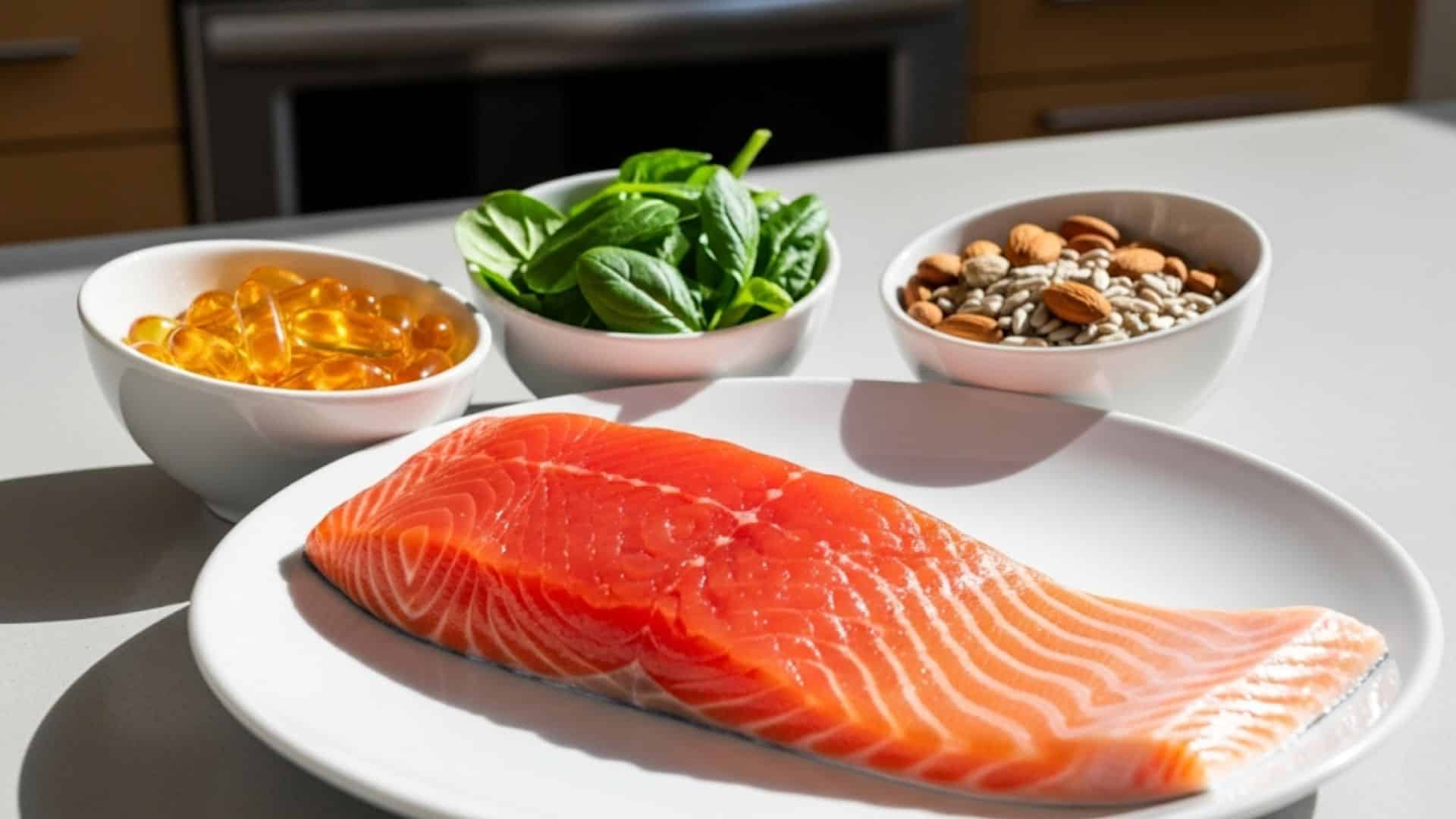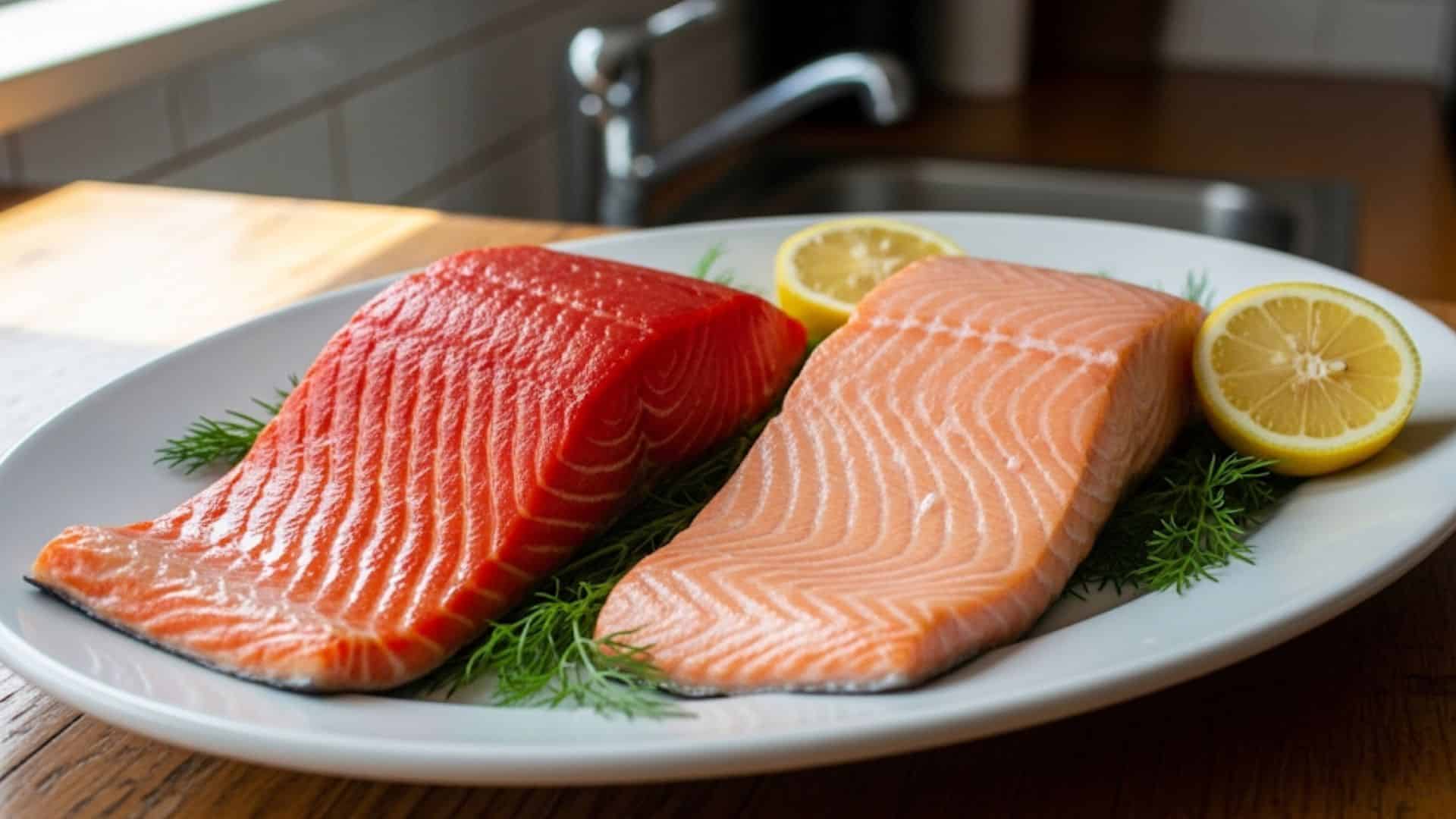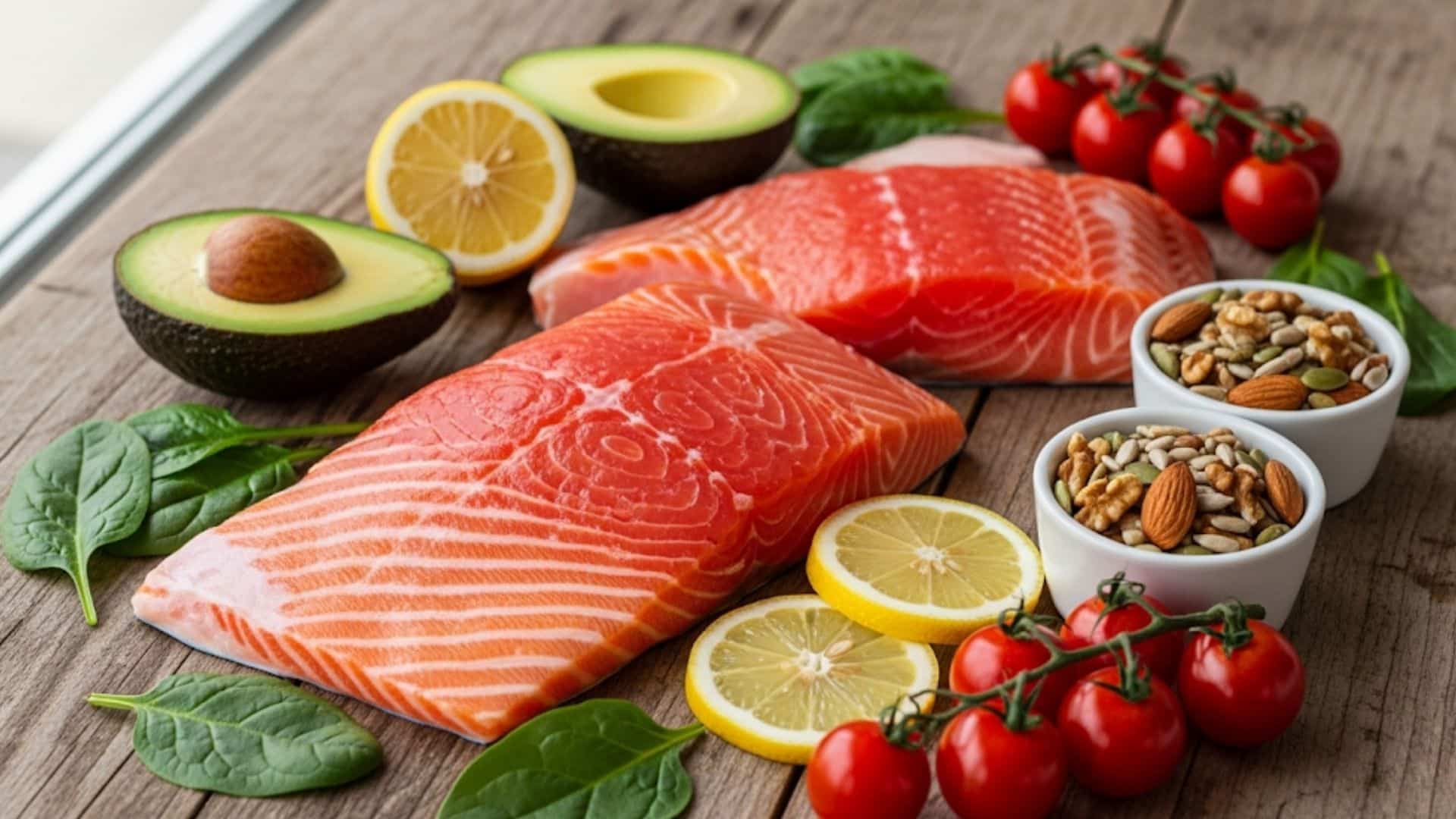Are you trying to eat better without overthinking every meal? I’ve been there too. That’s why I started adding Sockeye Salmon to my weekly routine.
It’s simple, tasty, and packed with real benefits. Sockeye Salmon nutritionally gives you protein, healthy fats, and key vitamins, all in one food.
What makes it even better is that it’s wild-caught and doesn’t come with all the stuff you find in processed foods.
You don’t need a cabinet full of supplements when one fish can support your brain, heart, and immune system.
In this post, I’ll share why Sockeye Salmon stands out. If you’re looking for food that actually helps you feel better and live a healthier life, this is a great place to start.
What Makes Sockeye Salmon Unique?
Sockeye Salmon is special because it is wild-caught in the Pacific Ocean. Its flesh is a deep red color. This red comes from Astaxanthin, a natural pigment found in its diet.
Sockeye Salmon is leaner than farmed Atlantic salmon, meaning it has less fat. It has a stronger flavor that many people enjoy.
Besides tasting good, it is packed with important nutrients like omega-3 fatty acids and protein. These nutrients help keep your heart healthy and body strong.
Wild-caught Sockeye also tends to be fresher and more natural than farmed salmon. That’s why it is a favorite for healthy meals.
Nutrition Facts Related to Sockeye Salmon

Sockeye Salmon packs about 156 calories in a 3.5-oz (100g) serving. It contains approximately 26 grams of protein and zero carbs, making it a very lean option.
The fat content is about 5.6 grams, mostly healthy fats including omega-3s like EPA and DHA. These fats help your heart and brain work well.
This fish is rich in vitamins such as B12, niacin, riboflavin, and vitamin D, all of which are important for energy and immune health.
It also contains minerals such as selenium, potassium, and phosphorus, which support your body in various ways.
Sockeye Salmon has very low saturated fat compared to other proteins. This makes it a smart choice for a healthy diet.
Health Benefits of Consuming Sockeye Salmon
Sockeye Salmon provides your body with essential nutrients that support multiple aspects of your health.
These key benefits show why adding this fish to your diet can improve your overall well-being:
- Heart health: Omega-3 fatty acids in Sockeye Salmon help lower blood pressure and reduce your risk of heart disease
- Brain support: DHA omega-3s boost memory, improve focus, and help maintain a stable mood throughout the day
- Immune system and bone health: Vitamin D and selenium strengthen your immune system and keep your bones strong
- Eye health: Astaxanthin antioxidant gives sockeye its red color while protecting your eyes from age-related damage
- Weight management: High protein content keeps you full longer while staying relatively low in calories for balanced nutrition
These benefits work together to support your body’s natural functions and long-term health. Eating Sockeye Salmon regularly can help you feel better and maintain energy throughout your day.
Sockeye Salmon vs. Other Types of Salmon
Different types of salmon offer unique nutritional profiles and flavors that appeal to diverse preferences.
I’ll compare Sockeye Salmon with other popular varieties to help you choose the best option:
1. Sockeye vs. Atlantic Salmon

Sockeye and Atlantic salmon differ significantly in their methods of cultivation and nutritional content.
These differences affect both taste and health benefits when you’re choosing between them:
| Feature | Sockeye Salmon | Atlantic Salmon |
|---|---|---|
| Source | Wild-caught | Usually farmed |
| Fat Content | Leaner | Higher fat content |
| Calories | Fewer calories | More calories |
| Nutrient Density | More nutrient-dense | Less nutrient-dense |
| Flavor | Stronger, richer taste | Milder flavor |
Atlantic salmon’s higher fat content makes it more tender, but also increases calories per serving.
Sockeye’s wild-caught nature typically provides more concentrated nutrients and a more intense flavor.
2. Sockeye vs. King (Chinook) Salmon

King salmon and Sockeye Salmon represent opposite ends of the salmon fat spectrum. Each type offers distinct advantages depending on your dietary goals and taste preferences:
| Feature | Sockeye Salmon | King Salmon |
|---|---|---|
| Fat Content |
Leaner | Higher fat |
| Omega-3s | Good levels | Higher omega-3 content |
| Calories | Lower calories | More calories |
| Flavor | Richer, more intense | Buttery, mild |
| Texture | Firmer | More tender |
King salmon provides the highest omega-3 content among all salmon types, but comes with more calories. Sockeye offers a good balance of nutrients with fewer calories for weight-conscious eaters.
3. Sockeye vs. Pink Salmon

Pink salmon and Sockeye Salmon sit at different quality levels in the salmon family. Understanding these differences helps you choose based on budget and nutritional needs:
| Feature | Sockeye Salmon | Pink Salmon |
|---|---|---|
| Fat Content | Higher fat | Lower fat |
| Omega-3s | More omega-3s | Lower omega-3s |
| Protein | Higher protein | Lower protein |
| Color | Deep red | Light pink |
| Taste | Rich, full flavor | Mild taste |
Pink salmon provides an affordable option for incorporating salmon into your diet on a regular basis. Sockeye provides more nutrients per serving but costs more than pink salmon varieties.
How to Include Sockeye Salmon in a Healthy Diet

I love including Sockeye Salmon in my diet because it’s packed with protein, omega-3 fatty acids, and essential vitamins.
It’s an easy way to support heart, brain, and overall health. Here are some simple recipes to get you started:
1. Grilled Honey Mustard Sockeye Salmon
This grilled salmon recipe is simple and tasty with a sweet and tangy glaze. You don’t need fancy tools, just a grill or grill pan. Follow these easy steps to get perfectly cooked salmon:
- Step 1: Preheat the grill to medium-high and oil the grates.
- Step 2: Mix honey, mustard, and lemon juice to make a glaze.
- Step 3: Brush glaze on salmon and grill skin side down for 5-7 minutes.
- Step 4: Flip carefully, grill 3-4 more minutes, then serve.
Pairing suggestion: Serve with roasted asparagus and quinoa for a fresh, filling meal.
2. Baked Lemon Garlic Sockeye Salmon
Baking salmon is easy and keeps it moist and flavorful. This recipe mixes simple ingredients to enrich the salmon’s natural taste. Here’s how to do it step-by-step:
- Step 1: Preheat oven to 375°F and line a baking sheet with foil.
- Step 2: Mix olive oil, lemon juice, garlic, salt, and pepper.
- Step 3: Place the salmon on foil, brush it with the mixture, and add lemon slices.
- Step 4: Wrap loosely in foil and bake 15-20 minutes.
Pairing suggestion: Pair with steamed green beans and wild rice for a nutritious dinner.
3. Steamed Maple Glazed Sockeye Salmon
Steaming salmon locks in moisture and light flavor, while a maple glaze adds a touch of sweetness. This method is quick and healthy. Follow these simple steps:
- Step 1: Whisk maple syrup, paprika, and chili powder in a bowl.
- Step 2: Place salmon in a steaming basket, brush with the glaze.
- Step 3: Steam over boiling water for 10-12 minutes until cooked.
- Step 4: Serve warm with your favorite veggies or salad.
Pairing suggestion: Great with a mixed green salad and roasted sweet potatoes for a balanced meal.
Sockeye Salmon vs. Other Seafood Choices
Sockeye Salmon offers better nutrition than many other popular seafood choices you might consider.
| Seafood Type | Omega-3 Fatty Acids | Protein Content | Fat Content | Vitamin D | Mercury Risk | Other Notes |
|---|---|---|---|---|---|---|
| Sockeye Salmon | Very high – supports heart and brain health | High | High in healthy fats | High – supports immunity and bones | Low | Nutrient-rich, low contamination risk, great for overall health |
| Tuna | Moderate – less than salmon | High | Moderate | Moderate | High (caution for children & pregnant women) | Popular but risky due to mercury; less omega-3s than salmon |
| Cod | Low | Moderate to High | Low | Low | Low | Lean white fish with fewer healthy fats |
| Tilapia | Low | Moderate | Low | Low | Low | Affordable, but offers fewer nutrients overall |
| Shellfish | Low to Moderate | Moderate | Low to Moderate | Moderate | Variable – depends on type | It can be healthy, but it lacks salmon’s omega-3 and vitamin D content |
Sockeye Salmon is a smart choice when you want nutrient-rich seafood with fewer contamination risks.
Key Considerations for Sockeye Salmon
While Sockeye Salmon offers many health benefits, there are some important factors to keep in mind. These considerations help you make informed decisions about including this fish in your diet
- Sustainability factors show that wild sockeye is generally more eco-friendly than farmed salmon options
- Cost differences mean sockeye often costs more than farmed salmon varieties at the grocery store
- Sodium content can be higher in smoked or canned versions compared to fresh Sockeye Salmon
- Food allergies or individual dietary restrictions may limit your ability to eat this fish safely
Understanding these factors helps you choose the best Sockeye Salmon options for your budget and needs.
Most people can enjoy this nutritious fish without major concerns about these considerations.
Wrapping It Up
Since I started adding Sockeye Salmon to my meals, I’ve felt more energized and just…better overall. It’s one of those foods that checks all the boxes: tasty, healthy, and easy to cook.
What makes it even better is knowing I’m giving my body real fuel. Sockeye Salmon has everything I need to stay strong and feel good all day.
And I don’t need a ton, just a couple of servings a week fit into my normal grocery routine without stress.
I use fresh, canned, or frozen, depending on what I’ve got. It all works and still gives those same benefits. If you haven’t added it to your weekly meals yet, give it a try. You might feel the difference like I did.
If you found this helpful, take a look at more blogs on the website for simple, everyday health tips!





